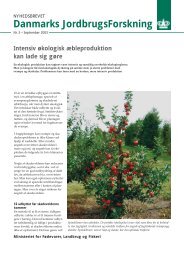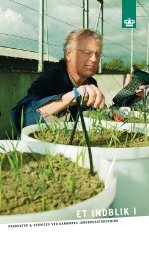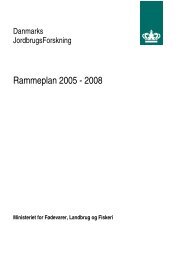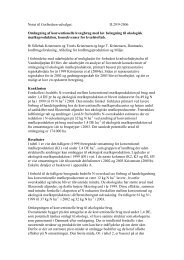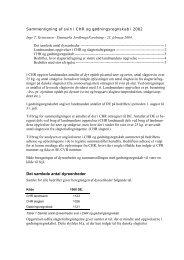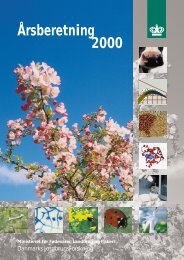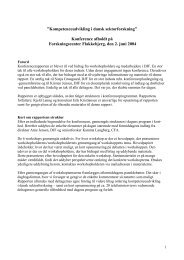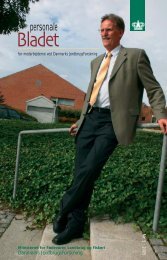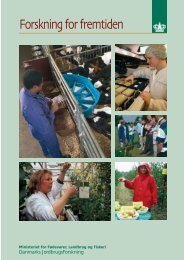Reproduction performances and conditions of group-housed non ...
Reproduction performances and conditions of group-housed non ...
Reproduction performances and conditions of group-housed non ...
Create successful ePaper yourself
Turn your PDF publications into a flip-book with our unique Google optimized e-Paper software.
- How does <strong>group</strong> housing vary in practice? -<br />
From weaning until four weeks after mating, individual feeding procedures are preferred,<br />
however, systems with <strong>group</strong> feeding procedures in the entire <strong>non</strong>-lactating period do also<br />
exist (Sørensen & Thorup, 2003; pers. comm. Hansen, 2004, own observations).<br />
Group dynamic/<strong>group</strong> size<br />
A <strong>group</strong> <strong>of</strong> <strong>non</strong>-lactating sows may either be stable or dynamic. In stable <strong>group</strong>s, once the<br />
<strong>group</strong> is established no new sows are moved into the <strong>group</strong>. In dynamics <strong>group</strong>s, new sows<br />
are constantly moved into <strong>and</strong> out <strong>of</strong> the <strong>group</strong> e.g. up till once a week (Svendsen et al.,<br />
1990). Group sizes may vary from 2 (Deininger, 1998) to 150 (Nielsen et al., 2000) sows<br />
per <strong>group</strong>. In the service unit the <strong>group</strong>s are <strong>of</strong>ten stable with <strong>group</strong> sizes equal to or less (if<br />
division into smaller <strong>group</strong>s take place at weaning) than the size <strong>of</strong> the farrowing batch.<br />
Mixing <strong>of</strong> unfamiliar sows<br />
Frequently, sows are individually <strong>housed</strong> in the lactating unit why sows usually are mixed<br />
with unfamiliar sows when moved from the lactation unit to the service unit (Edwards,<br />
1992; Deininger, 1998). In some herds the service <strong>and</strong> pregnancy units are integrated. In<br />
these systems sows stay in the same pen from weaning to shortly before farrowing. In many<br />
herds, however, sows are relocated at least once more when moved from the mating to the<br />
pregnancy section. This may happen in from a few hours to three-four weeks (own observations)<br />
after insemination.<br />
Stocking rate<br />
Stocking rates from less than 2 m 2 (Mortensen & Ruby, 1990; Deininger, 1998) to more<br />
than 4 m 2 per sow (Svendsen et al., 1990) or even 5 m 2 per sow (Deininger, 1998) are practised.<br />
Often, the stocking rate in the service unit is less compared to the stocking rate in the<br />
pregnancy unit (pers comm., Hansen 2004) because it is believed that a high stocking rate<br />
in this period may influence reproduction negatively.<br />
Floor type<br />
Systems exists with large ‘open’ floor plan with deep straw bedding, however, the floor<br />
may also be divided into a lying/activity <strong>and</strong> a dunging area (Olsson et al., 1991). The<br />
dunging area may consist <strong>of</strong> slatted or concrete floor. The lying/activity area may consist <strong>of</strong><br />
concrete with or without small amounts <strong>of</strong> straw provided, straw bedding or deep straw<br />
bedding (Deininger, 1998). It is common to use some amount <strong>of</strong> straw in the service unit<br />
because it is believed to minimize the risk <strong>of</strong> leg injuries caused by fighting <strong>and</strong> mounting<br />
during oestrus (Hansen & Kongsted, 2002). Depending upon the system in use, the amount<br />
<strong>of</strong> straw provided may vary from zero (own observations) to 1.000 kg per sow per year<br />
(Svendsen et al., 1990). The lying/activity area may be divided into smaller or larger ‘nests’<br />
by means <strong>of</strong> ‘pen dividers’ as shown in picture 3.<br />
17




